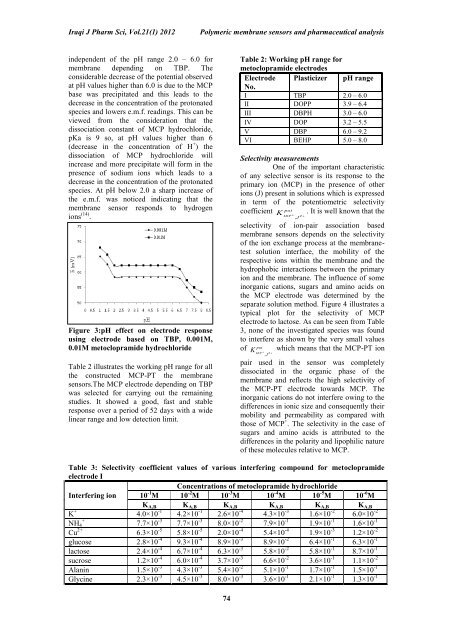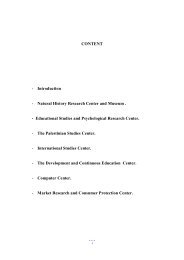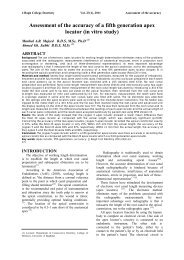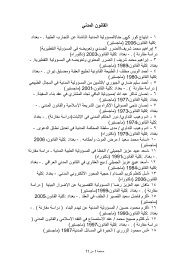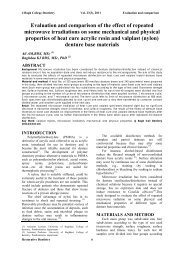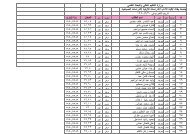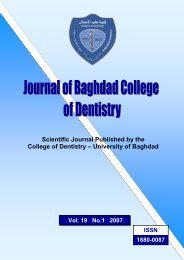Polymeric Membrane Sensors for The Selective Determination of ...
Polymeric Membrane Sensors for The Selective Determination of ...
Polymeric Membrane Sensors for The Selective Determination of ...
You also want an ePaper? Increase the reach of your titles
YUMPU automatically turns print PDFs into web optimized ePapers that Google loves.
Iraqi J Pharm Sci, Vol.21(1) 2012<br />
<strong>Polymeric</strong> membrane sensors and pharmaceutical analysis<br />
independent <strong>of</strong> the pH range 2.0 – 6.0 <strong>for</strong><br />
membrane depending on TBP. <strong>The</strong><br />
considerable decrease <strong>of</strong> the potential observed<br />
at pH values higher than 6.0 is due to the MCP<br />
base was precipitated and this leads to the<br />
decrease in the concentration <strong>of</strong> the protonated<br />
species and lowers e.m.f. readings. This can be<br />
viewed from the consideration that the<br />
dissociation constant <strong>of</strong> MCP hydrochloride,<br />
pKa is 9 so, at pH values higher than 6<br />
(decrease in the concentration <strong>of</strong> H + ) the<br />
dissociation <strong>of</strong> MCP hydrochloride will<br />
increase and more precipitate will <strong>for</strong>m in the<br />
presence <strong>of</strong> sodium ions which leads to a<br />
decrease in the concentration <strong>of</strong> the protonated<br />
species. At pH below 2.0 a sharp increase <strong>of</strong><br />
the e.m.f. was noticed indicating that the<br />
membrane sensor responds to hydrogen<br />
ions (14) .<br />
Figure 3:pH effect on electrode response<br />
using electrode based on TBP, 0.001M,<br />
0.01M metoclopramide hydrochloride<br />
Table 2 illustrates the working pH range <strong>for</strong> all<br />
the constructed MCP-PT the membrane<br />
sensors.<strong>The</strong> MCP electrode depending on TBP<br />
was selected <strong>for</strong> carrying out the remaining<br />
studies. It showed a good, fast and stable<br />
response over a period <strong>of</strong> 52 days with a wide<br />
linear range and low detection limit.<br />
Table 2: Working pH range <strong>for</strong><br />
metoclopramide electrodes<br />
Electrode Plasticizer pH range<br />
No.<br />
I TBP 2.0 – 6.0<br />
II DOPP 3.9 – 6.4<br />
III DBPH 3.0 – 6.0<br />
IV DOP 3.2 – 5.5<br />
V DBP 6.0 – 9.2<br />
VI BEHP 5.0 – 8.0<br />
Selectivity measurements<br />
One <strong>of</strong> the important characteristic<br />
<strong>of</strong> any selective sensor is its response to the<br />
primary ion (MCP) in the presence <strong>of</strong> other<br />
ions (J) present in solutions which is expressed<br />
in term <strong>of</strong> the potentiometric selectivity<br />
coefficient pot<br />
K . It is well known that the<br />
MCP<br />
, J Z<br />
<br />
selectivity <strong>of</strong> ion-pair association based<br />
membrane sensors depends on the selectivity<br />
<strong>of</strong> the ion exchange process at the membranetest<br />
solution interface, the mobility <strong>of</strong> the<br />
respective ions within the membrane and the<br />
hydrophobic interactions between the primary<br />
ion and the membrane. <strong>The</strong> influence <strong>of</strong> some<br />
inorganic cations, sugars and amino acids on<br />
the MCP electrode was determined by the<br />
separate solution method. Figure 4 illustrates a<br />
typical plot <strong>for</strong> the selectivity <strong>of</strong> MCP<br />
electrode to lactose. As can be seen from Table<br />
3, none <strong>of</strong> the investigated species was found<br />
to interfere as shown by the very small values<br />
<strong>of</strong> pot<br />
K which means that the MCP-PT ion<br />
MCP<br />
, J Z<br />
<br />
pair used in the sensor was completely<br />
dissociated in the organic phase <strong>of</strong> the<br />
membrane and reflects the high selectivity <strong>of</strong><br />
the MCP-PT electrode towards MCP. <strong>The</strong><br />
inorganic cations do not interfere owing to the<br />
differences in ionic size and consequently their<br />
mobility and permeability as compared with<br />
those <strong>of</strong> MCP + . <strong>The</strong> selectivity in the case <strong>of</strong><br />
sugars and amino acids is attributed to the<br />
differences in the polarity and lipophilic nature<br />
<strong>of</strong> these molecules relative to MCP.<br />
Table 3: Selectivity coefficient values <strong>of</strong> various interfering compound <strong>for</strong> metoclopramide<br />
electrode I<br />
Concentrations <strong>of</strong> metoclopramide hydrochloride<br />
Interfering ion 10 -1 M 10 -2 M 10 -3 M 10 -4 M 10 -5 M 10 -6 M<br />
K A,B K A,B K A,B K A,B K A,B K A,B<br />
K + 4.0×10 -1 4.2×10 -1 2.6×10 -4 4.3×10 -3 1.6×10 -2 6.0×10 -2<br />
+<br />
NH 4 7.7×10 -3 7.7×10 -3 8.0×10 -2 7.9×10 -1 1.9×10 -1 1.6×10 -1<br />
Cu 2+ 6.3×10 -5 5.8×10 -5 2.0×10 -4 5.4×10 -4 1.9×10 -3 1.2×10 -2<br />
glucose 2.8×10 -4 9.3×10 -4 8.9×10 -3 8.9×10 -2 6.4×10 -1 6.3×10 -1<br />
lactose 2.4×10 -4 6.7×10 -4 6.3×10 -3 5.8×10 -2 5.8×10 -1 8.7×10 -1<br />
sucrose 1.2×10 -4 6.0×10 -4 3.7×10 -3 6.6×10 -2 3.6×10 -1 1.1×10 -2<br />
Alanin 1.5×10 -3 4.3×10 -3 5.4×10 -2 5.1×10 -1 1.7×10 -1 1.5×10 -1<br />
Glycine 2.3×10 -3 4.5×10 -3 8.0×10 -3 3.6×10 -1 2.1×10 -1 1.3×10 -1<br />
74


